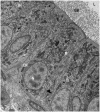Zebrafish lipid metabolism: from mediating early patterning to the metabolism of dietary fat and cholesterol
- PMID: 21550441
- PMCID: PMC3593232
- DOI: 10.1016/B978-0-12-387036-0.00005-0
Zebrafish lipid metabolism: from mediating early patterning to the metabolism of dietary fat and cholesterol
Abstract
Lipids serve essential functions in cells as signaling molecules, membrane components, and sources of energy. Defects in lipid metabolism are implicated in a number of pandemic human diseases, including diabetes, obesity, and hypercholesterolemia. Many aspects of how fatty acids and cholesterol are absorbed and processed by intestinal cells remain unclear and present a hurdle to developing approaches for disease prevention and treatment. Numerous studies have shown that the zebrafish is an excellent model for vertebrate lipid metabolism. In this chapter, we review studies that employ zebrafish to better understand lipid signaling and metabolism.
Copyright © 2011 Elsevier Inc. All rights reserved.
Figures











References
-
- Apelqvist A, Li H, Sommer L, Beatus P, Anderson DJ, Honjo T, Hrabe de Angelis M, Lendahl U, Edlund H. Notch signalling controls pancreatic cell differentiation. Nature. 1999;400:877–881. - PubMed
-
- Begle A, Tryoen-Toth P, de Barry J, Bader MF, Vitale N. ARF6 regulates the synthesis of fusogenic lipids for calcium-regulated exocytosis in neuroendocrine cells. J Biol Chem. 2009;284:4836–4845. - PubMed
Publication types
MeSH terms
Substances
Grants and funding
LinkOut - more resources
Full Text Sources
Medical

